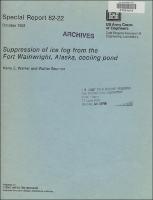Please use this identifier to cite or link to this item:
https://hdl.handle.net/11681/11963| Title: | Suppression of ice fog from the Fort Wainwright, Alaska, cooling pond |
| Authors: | United States. Army. Infantry Brigade, 172nd Walker, Kerry E. Brunner, Walter |
| Keywords: | Automotive vehicles Ice fog Cooling ponds Ice fog prevention Hazards Motor vehicle accidents Hexadecanol Waste heat Fort Wainwright (Alaska) |
| Publisher: | Cold Regions Research and Engineering Laboratory (U.S.) Engineer Research and Development Center (U.S.) |
| Series/Report no.: | Special report (Cold Regions Research and Engineering Laboratory (U.S.)) ; 82-22. |
| Description: | Special Report Abstract: Ice fog near the Ft. Wainwright cooling pond creates a visibility hazard. Observations show a substantial reduction in visibility along both private and public roadways in the path of the cooling pond's ice fog plume. This reduction in visibility increases as the ambient air temperature decreases. Visibility was less than 215 m (700 ft) on the Richardson Highway on the average of 8 days for each of the 3 data years. Data collected during the winters of 1979-80, 1980-81 and 1981-82 statistically show that use of a monomolecular film evaporation suppressant, hexadecanol (C16H33OH), on the pond to reduce ice fog is ineffective. There is an immediate need for a driver warning system when visibility is affected by the ice fog. |
| Rights: | Approved for public release; distribution is unlimited. |
| URI: | http://hdl.handle.net/11681/11963 |
| Appears in Collections: | Special Report |
Files in This Item:
| File | Description | Size | Format | |
|---|---|---|---|---|
| SR-82-22.pdf | 8.47 MB | Adobe PDF |  View/Open |